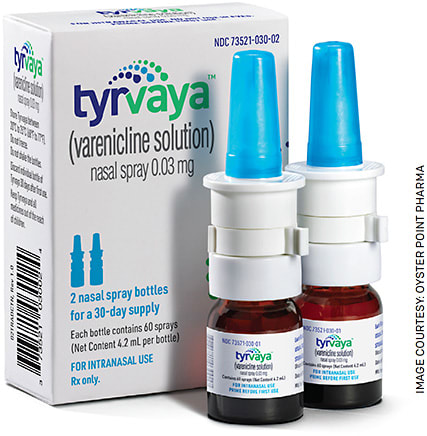FDA approves Oyster Point Pharma’s Tyrvaya as the first nasal spray for dry eye disease.

Nearly 16 million people in the United States suffer from the itching, burning and other discomforts of dry eye disease (DED), according to the National Eye Institute. But ophthalmologists can now offer this patient population a new and unique treatment alternative to artificial tears.
Oyster Point Pharma’s Tyrvaya (varenicline tartrate solution (0.03 mg) received FDA marketing approval in September as the first and only nasal spray for the treatment of the signs and symptoms of DED.
NOVEL MECHANISM OF ACTION
Unlike artificial tears, which work directly on the cornea to reduce inflammation, Tyrvaya is a highly selective cholinergic agonist that stimulates the trigeminal parasympathetic pathway. Accessible through the nose, the pathway plays an important role in basal tear film production by the lacrimal glands, goblet cells and meibomian glands.
“With this new nasal spray, we can take advantage of the knowledge of this trigeminal parasympathetic pathway that integrates all three structures in the lacrimal functional unit to help with tear homeostasis by improving that basal tear film,” says Vance Thompson, MD, director of refractive surgery for Vance Thompson Vision in Sioux Falls, S.D.
“There are over 1,500 proteins in tears, along with multiple other lipids and mucins that provide strong anti-inflammatory and strong antimicrobial abilities,” Dr. Thompson adds. “No drop has ever been invented to reproduce our own natural tears. They’re very complicated, and it is something that is revolutionary in dry eye therapy.”
FASTER ONSET
According to the company, in clinical trials involving more than 1,000 patients with Eye Dryness Scores of 2 to 100 and Schirmer’s test scores <10 mm, Tyrvaya demonstrated dramatically faster onset of action than eyedrops. At 5 minutes post-administration in the ONSET-1 trial, Schirmer’s test scores for the Tyrvaya group were 17.2 mm vs 4.0 mm in the control group. In the ONSET-2 trial, Schirmer’s scores for the Tyrvaya group were 16.5 mm vs 6.9 mm in the vehicle group.
These results held steady at 4 weeks and 12 weeks. Subjects were permitted to use artificial tears to mimic real-world conditions during the trials, which the company says did not affect signs or symptom endpoints.
“The approval of Tyrvaya nasal spray marks a milestone for patients and eye-care professionals by providing a new drug treatment option for the signs and symptoms of DED with a differentiated route of administration that is believed to leverage a nerve pathway that can be accessed within the nose,” says Jeffrey Nau, PhD, MMS, president and CEO, Oyster Point Pharma. “In any therapeutic area, it’s always an exciting moment when you follow the science and develop a truly innovative pharmaceutical treatment option for patients that addresses an important unmet medical need.”
BENEFITS OF NATURAL TEARS
Administered twice daily into each nostril, Tyrvaya’s advantages over eyedrops include a milder side-effect profile. In clinical trials, a brief sneeze (82%) and cough (between 5% and 16%) were the most common side effects, along with mild throat and nasal irritation.
“One of the problems with drops is that patients already have an irritated corneal surface, and a lot of drops involve burning and stinging,” Dr. Thompson says. He notes that a 2019 study by White et al found some 60% of DED patients discontinue treatment within 12 months. “The idea of being treated so effectively without having to use eyedrops is very attractive to patients. There’s nothing hitting the eye except your own natural tear.
“It’s a very frustrating disease. Post-approval, we are finding that patients are very interested in this [treatment], and I think the novel delivery is very powerful because dry eye patients don’t always like putting drops on their irritated eyes,” he says.
A ‘TEAR FILM TRIFECTA’
Currently, Tyrvaya is not reimbursed by most payers, but the company does offer financial assistance to eligible patients, according to Dr. Thompson.
With its rapid and consistent increase in basal tear secretion, its novel route of administration and the biological benefits of stimulating the body to heal itself from within, Dr. Thompson believes that Tyrvaya is poised to become a major addition to dry eye treatment.
“We have what I call a ‘tear film trifecta,’” he says. “I think this will revolutionize dry eye care.” OM








